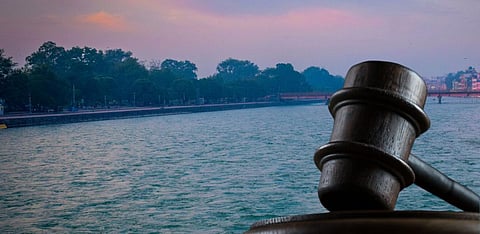

Development of rivers through canals and dams and water conservation must go hand-in-hand for a better water budget for India, a country that has percent of the world's freshwater resources but 18 percent of its population.
—
RIVER water management is a multidisciplinary issue and has many faces. This is true for the Indian context as well. River water management in India extends into the technical, policy face and legal dimensions.
River water or fresh water is not in abundance. Generally, only 3 percent of the water in the hydrological cycle is surface water. Of this, 60 percent is underground, 20 percent is frozen in glaciers and 20 percent flows in rivers.
There are about 10,360 rivers and tributaries in India. The annual average flow in all river basins in India is estimated at 1,869 cubic kilometers. However, only roughly 690 cubic kilometers (32 percent) of the available surface water can be used due to topographical, hydrological and other limitations.
River water or fresh water is not in abundance. Generally, only 3 percent of the water in the hydrological cycle is surface water.
The source water in rivers is rainwater and melting snow. Rivers blessed with both rainwater and melting snow are perennial. Rivers that only rely on rainwater are seasonal since rains occur mainly in monsoons.
India possesses about 4 percent of the world's water resources. But it is home to roughly 18 percent of the world's population. The average annual precipitation in India is about 4,000 billion cubic meters (BCM).
Of the 4,000 BCM of water coming from precipitation annually, the available water after accounting for losses by seepage and evaporation is 1,869 BCM.
Of this available water, the utilisable water after accounting for hydrological constraints and river flows is estimated to be 1,123 BCM, which includes 690 BCM of surface water and 433 BCM of groundwater.
The per capita availability of water in India has decreased and it is estimated that it was 5,177 cubic meters in 1951 but in 2025 its likely to be 1341 cubic meters. At this rate, by 2050, it is likely to go down further to 1,140 cubic meters.
Hence, it is critical to boost the water supply in India through development and conservation.
“Of the 4,000 BCM of water coming from precipitation annually, the available water after accounting for losses by seepage and evaporation is 1,869 BCM.
The State generally as a trustee of public trust has a responsibility to harness and distribute water in the public interest. Even though the State is not the owner of water, it has a constitutional responsibility to harness and conserve water. However, it must act fairly and its policies must be consistent with ecological protection.
Inter-state rivers and river valleys are under the Union government under Entry 56 of the Union List. However, the Union has not activated its role. The River Board's Act of 1956 has been enacted, but no board has been constituted till now.
Thus, the participatory approach to developing inter-state rivers has failed so far. States develop water independently and if there is any clash of interest causing transboundary injury, they are compelled to resort to inter-state litigation by invoking the provisions of the Inter-State River Water Disputes Act of 1967 read with Article 262 of the Constitution.
The famous inter-state water dispute tribunals relate to Krishna, Godavari, Narmada, Cauvery, Ravi–Beas, Vamsadhara and Mahanadi.
The development of water involves the building of dams and canals. States in India undertake this work. There is no prohibition on privatisation. In India, the works are undertaken by the state government directly or through its agencies. The private sector has entered into the development of water in hydropower generation and drinking water supply.
Avoiding excess or wasteful utilisation of water is also part of its development. Whose responsibility is it to conserve or save water? In a legal sense, both individuals and the State have the obligation.
In India, the government has popularised various schemes to save water by improving the transmission and distribution system and by promoting less water-intensive crops.
Besides States, the Union government has schemes such as the Accelerated Irrigation Benefit Programme, Watershed Development, Har Khet Ko Pani and Per Drop More Crop to fund the conservation and saving of water.
On the individual side, the duty to conserve and save water is a controversial issue. Because nobody has rights in flowing water. Nobody has the right to ownership of water. Water rights are limited to their actual uses known in law as usufructuary rights. The right excludes wasteful use and puts an obligation to save water. However, the troubling question is: Who gets the benefits of water saved by conservation?
“The development of water involves the building of dams and canals. States in India undertake this work. There is no prohibition on privatisation.
In the United States of America, in states that follow the prior appropriation doctrine, farmers who save water do not get the benefits of the water saved. It goes to the general pool and the government is free to distribute it.
Because water right is founded on the doctrine of beneficial use. The famous words are that beneficial use is the "basis, the measure and limit of the appropriators right".
If a water user conserves and saves the water through improvements through his investments, he should get the benefits of saving or salvaging the water prima facie.
However, this promotes the status quo and deprives water to new users which is a res communis or common heritage of mankind. Thus, what is appropriate depends on what is just and reasonable in a given situation.
The article is an updated version of a speech delivered by the author on March 14, 2024 at Workshop on International Day of Action for Rivers organised by Environmental Management and Policy Research Institute, Bengaluru.